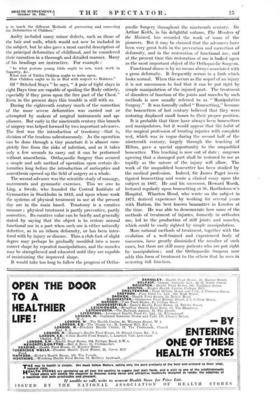Orthopaedic and Manipulative Surgery
BY R. C. ELMSLIE.
THE name Orthopaedic applied to a branch of surgery is often misunderstood. Because of a supposed derivation from the Latin pes, it is incorrectly associated with the surgery of the foot. The name was invented by a French physician, Dr. Andry, who in 1741 wrote a small book which was translated into English two years later and was entitled Orthopaedia, or the Art of Correcting and Preventing Deformities in Children. The derivation of the name may be given in Andry's own words : " As to the Title, I have formed it of two Greek words, viz. : Op9bs, which signifies streight, free from Deformity, and Haidor, a child. Out of these two words, I have compounded that of Orthopaedia, to express in one term the Design I propose, which
is to teach the different Methods of preventing and correcting the Deformities of Children."
Andry included many minor defects, such as those of the hair and nails, which would not now be included in the subject, but he also gave a most careful description of the principal deformities, of childhood, and he considered their causation in a thorough and detailed manner. Many of his headings are instructive. For example :-
" In what posture young Girls ought to sew, read, work in Tapestry, &c. What sort of Tables Children ought to write upon. Row Children ought to lie in Bed with respect to Bolsters."
Of " Stitched Stays " he says, " A pair of tight stays in eight Days time are capable of spoiling the Body entirely, especially if they press upon the free part of the Chest." Even in the present days this trouble is still with us.
During the eighteenth century much of the correction of the more severe deformities was carried out or attempted by makers of surgical instruments and ap- pliances. But early in the nineteenth century this branch of surgery was helped forward by two important advances. The first was the introduction of tenotomy—that is, division of the tendons subcutaneously. As the operation can be done through a tiny puncture it is almost com- pletely free from the risks of infection, and as it takes only a few seconds to carry out it can be performed without anaesthesia. Orthopaedic Surgery thus secured a simple and safe method of operation upon certain de- formities long before the introduction of antiseptics and anaesthesia opened up the field of surgery as a whole.
The second advance was the scientific study of massage, movements and gymnastic exercises. This we owe to Ling, a Swede, who founded the Central Institute of Gymnastics in Stockholm in 1813, and upon whose work the systems of physical treatment in use at the present day are in the main based. Tenotomy is a curative measure ; physical treatment is partly preventive, partly corrective. Its curative value can be briefly and generally stated by saying that the object is to restore normal functional use in a part when such use is either naturally defective, as in an inborn deformity, or has been inter- fered with by injury or disease. Thus a club foot of slight degree may perhaps be gradually moulded into a more correct shape by repeated manipulations, and the muscles may be strengthened and educated until they are capable of Maintaining the improved shape.
It would take too long to follow the progress of Ortho- paedic Surgery throughout the nineteenth century. Sir Arthur Keith, in his delightful volume, The Menders of the Maimed, has recorded the work of some of the pioneers. But it may be claimed that the advances have been very great both in the prevention and correction of deformity, and in the restoration of functional use, and at the present time this restoration of use is looked upon as the most important object of the Orthopaedic Surgeon.
Functional disuse is by no means always associated with a gross deformity. It frequently occurs in a limb which looks normal. When this occurs as the sequel of an injury it is not uncommon to find that it can be put right by simple manipulation of the injured part. The treatment of disorders of function of the joints and muscles by such methods is now usually referred to as " Manipulative Surgery." It was formally called " Bonesetting," because the bonesetters of last century believed that they were restoring displaced small bones to their proper position.
It is probable that there have always been bonesetters and manipulators, but it would appear that the habit of the surgical profession of treating injuries with complete rest, which was in vogue during the second half of the nineteenth century, largely through the teaching of Hilton, gave a special opportunity to the unqualified bonesetter. This teaching is now out of date ; surgeons agreeing that a damaged part shall be restored to use as rapidly as the nature of the injury will allow. The work of the unqualified bonesetter has been studied by the medical profession. Indeed, Sir James Paget inves- tigated bonesetting and wrote a clinical essay upon the subject in 1867. He and his successor, Howard Marsh, lectured regularly upon bonesetting at St. Bartholomew's Hospital. Wharton Hood, who wrote on the subject in 1871, derived experience by working for several years with Hutton, the best known bonesettcr in London at the time. He was able to demonstrate how some of the methods of treatment of injuries, formerly in orthodox use, led to the production of stiff joints and muscles, which could be easily righted by simple manipulation.
More rational methods of treatment, together with the evolution of a well-trained and experienced body of masseurs, have greatly diminished the number of such cases, but there are still many patients who arc put right by manipulation ; and the Orthopaedic Surgeon now adds this form of treatment to the others that he uses in restoring full function.



















































 Previous page
Previous page